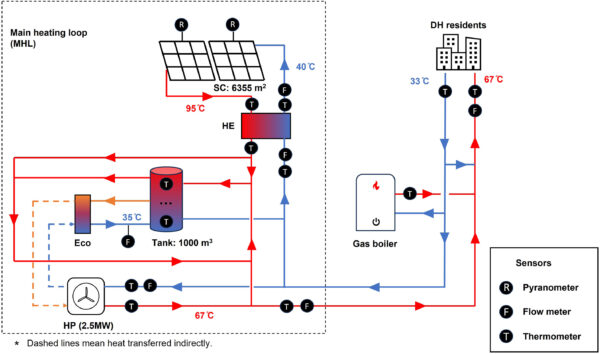Researchers at the Technical University of Denmark have investigated how large-scale air-to-water heat pumps could be combined with PV-powered district heating systems with the aim to reduce the levelized cost of heat and improve system flexibility. They explained that air-to-water heat pumps have the ability to produce and store heat in tanks when electricity prices are low, which allows using the stored heating during periods of high electricity prices.
The proposed approach was simulated through TRNSYS software in an existing solar-assisted district heating system in the Danish city of Ørum. The system consists of a ground-mounted solar thermal plant, a 2.5 MW heat pump, a gas boiler, and a vertical cylindrical hot water tank of 1,000 m3.
“In this system, the heat pump plays a dominant role in a fluctuating energy market due to its flexibility in cooperation with the boiler,” the scientists explained. “The medium to low-temperature water in the tank can preheat the refrigerant before it enters the compressor, thereby increasing the coefficient of performance (COP) of the heat pump. Consequently, the heat pump is expected to enhance equipment compatibility and the flexibility of the heating system.”
The group assumed the system to operate between 2020 and 2022 and specified it operated without the heat pump in the first year, while the second and third years included it. The 6,355 m2 solar thermal plant is able to meet the heat demand during summer, but in winter gas boilers are needed to meet the larger demand. The tank can be operated in different modes to decouple heat production and demand.

Image: Technical University of Denmark, Renewable Energy, Common License CC BY 4.0
The heat pump is assumed to use ammonia as the refrigerant and to rely on a screw compressor and a piston compressor. The outlet temperature is indicated at 67 C.
“An economizer is incorporated to elevate the temperature of the refrigerant before it enters the compressor,” the group emphasized. “This enhancement leads to a reduction in electricity consumption, as the compressor maintains the required outlet temperature more efficiently compared to a heat pump system without an economizer.”
The techno-economic analysis conducted by the scientists showed that the economizer was able to increase the heat pump COP from 3.33 to 3.53 with an ambient temperature lower than 5 C. It also showed that the levelized cost of heat of the system improved by up to 19% in 2021 and 37% in 2022.
“The heat production of the heat pump decreases as electricity prices rise to an acceptable level,” the group explained. “Once the electricity spot price exceeds a certain threshold, the heat pump shuts down, and the boiler becomes the main auxiliary heater.”
The analysis also showed that the system's annual seasonal COP increased from 1.22 to 2.62 during the 3-year time frame of the simulation.
“However, the coupling effect of the heat pump and its economizer only slightly enhanced the efficiency of the solar collector and heat pump itself,” the academics said. “The replacement of the air-source heat pump with a water-to-water heat pump could lower the return water temperature of the SC field, which is expected to boost the SC efficiency.”
The details of the system are available in the study “Thermo-economic analysis of a solar district heating plant with an air-to-water heat pump,” published in Renewable Energy.
This content is protected by copyright and may not be reused. If you want to cooperate with us and would like to reuse some of our content, please contact: editors@pv-magazine.com.




If the heat pump is positioned to be in the right direction of the main wind direction, its cooling effect may even boost solar yield. Though if faced opposite the heat pump may benefit from increased air temperature.